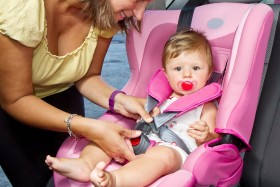Keep Your Child Safe in the Car With the Right Car Seat

Everybody wants to do everything they can to protect their children. Since cars are a necessary part of many people’s lives, keeping kids safe in the car is a naturally a big priority for many parents. The seat belts that come standard in cars are designed to protect adult-sized bodies; they don’t offer the same amount of protection for children. This is why children need the protection of a car seat or booster seat to stay safe in the event of a car accident. Car seats might seem like a hassle to deal with, but it’s essential to use them for every trip, even if you’re just going to the store two blocks away. But finding the right car seat can be a confusing process. How long does my child need to be in a rear-facing seat? When is it okay for a child to sit in the front seat? Let’s take a look at all the different options.
Remember that age recommendations for car seats are simply that — recommendations. Always follow the height and weight recommendations provided by the car seat’s manufacturer. It’s time to move on to the next type of car seat when the child either exceeds the manufacturer’s guidelines or the top of their head reaches higher than the back of the car seat, which ever happens first. If the top of their head isn’t even with the top of the car seat or below it, they won’t be adequately protected during a car accident.
Rear-facing car seats are for babies one year old and younger. It’s good to keep your baby rear facing as long as you possibly can because this position offers greater protection for the baby’s delicate head, neck, and spine in the event of an accident. When the child outgrows this seat, it’s time to move on to a forward-facing seat.
Forward-facing seats have either a three-point harness, a five point-harness, or an overhead shield that will keep the kids in the seat. These will limit the child’s forward head movement and make contact with the strongest parts of their bodies. Seats with a five-point harness are generally the most highly recommended because they can be better adjusted to fit your child. Forward-facing seats are generally used by kids aged 1-3 years.
When your child exceeds the manufacturer’s height and weight requirements of their forward-facing seat, they can make the switch to a booster seat. Booster seats come in two different styles: full booster seats and backless booster seats. Full booster seats provide extra back support for kids who are too young to be able to sit up straight on their own, but backless booster seats are recommended for kids who can sit up straight without assistance, typically around age 6. In either case, booster seats don’t have any special harnesses or restraints; they work by giving the child the extra height they need to better fit the car’s seat belt.
So, when is it okay for a child to use regular seat belts without a car seat or booster seat? A child should be at least 4’9” tall, tall enough for their knees to bend right at the edge of the seat. The shoulder strap of a seat belt should fit comfortably across the shoulder and chest without crossing the neck or arms and the lap belt portion should rest on the lower hip/upper thigh area.
Regardless of which type of car seat they’re using, the NHTSA recommends all children age 12 and under stay in the back seat. This can reduce the risk of a child dying in a car accident by up to 27%. If you have a vehicle that doesn’t have a back seat and it’s essential to put a child in the front seat, disable the front passenger airbag if possible.
If you’re involved in a car accident, do you need to replace the car seat? It depends on how severe the accident is. If it’s a minor accident like a fender-bender, the car seat should be fine to continue using. The NHTSA defines a minor accident as one where the car can be driven away from the accident scene, the door closest to the car seat is undamaged, nobody is injured, the airbags didn’t deploy, and the car seat doesn’t have any visible damage. But car seats need to be replaced after moderate or severe accidents because they could damage the car seat to the point that it will no longer offer enough protection for a child.
Overwhelmed by all the different car seat options out there? SaferCar.gov has a helpful tool that can provide you with a list of car seats that would be right for you based on your child’s birthdate, height and weight. When looking for a car seat, you not only need to consider your child’s age, height, and weight, you also need to look for one that will fit will inside your car. If you’re thinking of buying a used car seat, avoid ones that are older than six years old or have cracks and other signs of wear. Even if you’re buying a brand new car seat, it’s smart to do some research to see if any recalls have been issued for it.
Our personal injury lawyers at the Law Offices of Goodwin & Scieszka are experienced in other areas of injury law, everything from medical malpractice claims to slip and fall accidents. Contact us if you have been injured to see how we can help you on the road to recovery with fair compensation.






